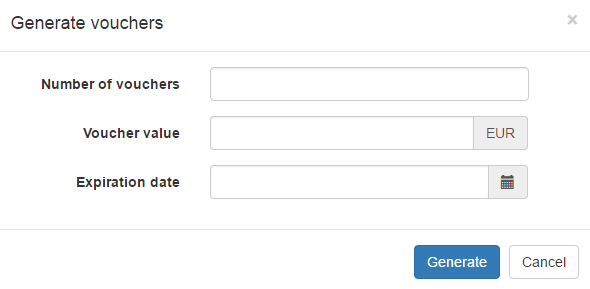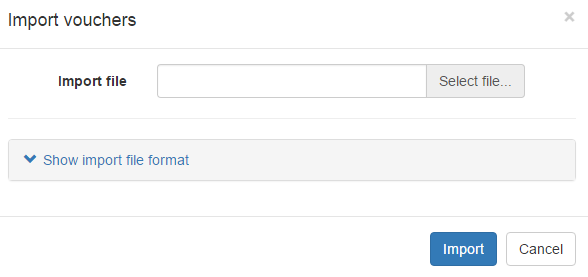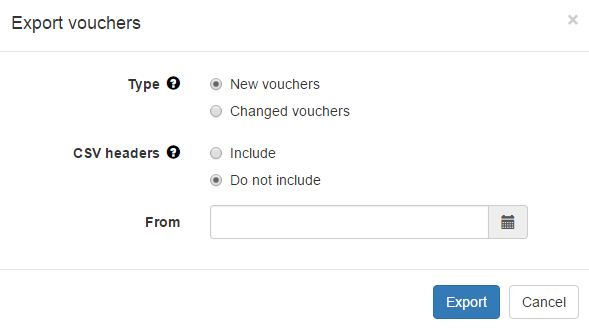Dispatcher Paragon Payment System Administration web interface
Prerequisites
Check these prerequisites before using Dispatcher Paragon Payment System Administration web interface:
-
Dispatcher Paragon Payment System is connected to Dispatcher Paragon Management server (for more information see safeq.authentication.address in Advanced configuration of Dispatcher Paragon Payment System)
-
At least one user with role > " Dispatcher Paragon Administrators with full access right" is available in Dispatcher Paragon (for more information about required Dispatcher Paragon roles, see Configuring Dispatcher Paragon Payment System).
-
Services Dispatcher Paragon Payment System and Dispatcher Paragon Management Server are running
Log In/Out
There are several ways how to get to Administration login page:
-
use shortcut named Dispatcher Paragon Payment System web interface, which should be on a desktop of your Dispatcher Paragon Payment System server
-
go to the index page https://<PAYMENT-SERVER-HOST>:8443 and click on link Payment System Administration
-
use direct link https://<PAYMENT-SERVER-HOST>:8443/payment-system/admin
Log In With Credentials
-
Go to the Dispatcher Paragon Payment System Administration login page.
-
Enter credentials of Dispatcher Paragon user with administrator rights (role Dispatcher Paragon Administrators with full access right ).
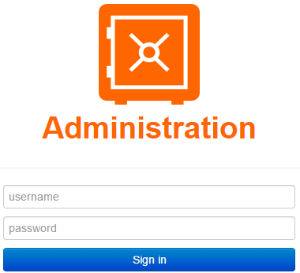
-
Click Log in.
Log In As Current Windows User
This feature is not available in default configuration of Dispatcher Paragon Payment System. For more information about configuration of Single Sign On, see Configuring Single Sign-on for Dispatcher Paragon Payment System.
-
Go to the Dispatcher Paragon Payment System Administration login page.
-
Click link Log in as current Windows user.
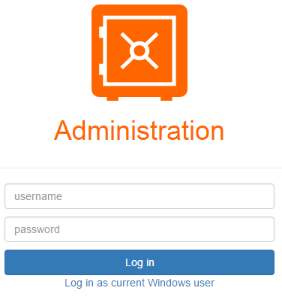
Log Out
Log out button is located in the top right corner. User will also be automatically logged out after long inactivity(for more information about session timeout, see Session Timeout).

Administration Overview
Administration web interface is dedicated for system administrators. Its left menu is divided into two main sections:
-
Manage – allows administrators to manage (create, modify, delete) objects that are in Dispatcher Paragon Payment System
-
Configure – allows administrators to configure different settings and features for Dispatcher Paragon Payment System and for Cash Desk as well
Common Actions
|
Action |
Description |
Example |
|
Language selection |
You can select language of Administration web interface at the top right corner. |
|
|
Filtering |
Some tables allow filtering of results. Filter is always located at the top of page, above table header. Filter fields usually represents table columns. Button "reset" will set filter fields to their default values. Page refresh will also trigger filter reset. |
|
|
Sorting |
Some table columns allows sorting. Following icons represent ascending |
|
|
Pagination |
Default table view will display maximum of 10 records per page. You can change this limit in table top right corner. Allowed values are 10, 25, 50 and 100 records per page. Present table page is represented by a number inside of blue square at the bottom of the table. Icons », «, »», «« will move you to the next, previous, last and first page, respectively. Pagination is not affected by page refresh. |
|
|
Bulk actions |
Some tables contain check boxes. These are used for bulk actions located at the bottom of the table. Bulk action buttons are clickable only after selecting at least one record. Check box located at the top left corner will select all records from the present table page. |
|
|
View detail |
Some table records have a "View" link at the end of their row. This link will display more details about the record. |
|
|
View all |
Some details display previews from additional tables (for example "Last 5 transactions"). Link "view all" will forward you to the full table view. |
|
|
Remove action |
These actions generally remove selected records from the view in the Administration web interface. In some cases, records remain in database for auditing purposes. Remove actions are final and cannot be reverted. |
|
Management
Entitlements
Entitlement defines which kind of services can be used by Dispatcher Paragon user (subject) in Dispatcher Paragon Payment System. There are following types of entitlements: Prepaid account (user has money balance to pay for services), Page quota (user can use services to a limited amount), No access (user is not allowed to use Dispatcher Paragon Payment System services) and Unlimited access (user is allowed to print or copy unlimitedly). Each entitlement has unique set of criteria used for matching of Dispatcher Paragon users either by username or by cost center number. If no entitlement matches these criteria, Dispatcher Paragon Payment System will assign Default entitlement to a user. Dispatcher Paragon users are in Dispatcher Paragon Payment System represented as subjects. Each entitlement can further define type-specific attributes (for example minimum balance or quotas), which are assigned to matched users during transaction request or during saving of entitlement. Dispatcher Paragon Payment System will automatically create new subjects based on matched entitlement.
Here are few basic examples of entitlement matching.
-
Match of new subject
-
Dispatcher Paragon user is assigned to cost center number 0 and has no corresponding subject in Dispatcher Paragon Payment System.
-
User logs into Dispatcher Paragon Embedded Terminal or YSoft end user interface.
-
Dispatcher Paragon User is matched by some entitlement criteria (for example default entitlement with prepaid account type).
-
Dispatcher Paragon Payment System automatically creates a new corresponding subject based on type-specific criteria of matched entitlement (for example subject with prepaid account type and with zero initial and minimum balance).
-
-
Match of existing subject with changed cost center
-
Dispatcher Paragon user is assigned to cost center number 0 and has one corresponding subject in Dispatcher Paragon Payment System.
-
Dispatcher Paragon Payment System subject is assigned to entitlement matching cost center number 0 (entitlement type is for example "Prepaid account").
-
Dispatcher Paragon User is assigned to new cost center number 1. Subject in Dispatcher Paragon Payment System remains unchanged.
-
User logs into Dispatcher Paragon Embedded Terminal or YSoft end user interface.
-
Dispatcher Paragon User is matched by different entitlement criteria (for example Quota entitlement).
-
Dispatcher Paragon Payment System subject is assigned to the lastly matched entitlement (in this example, "prepaid account" subject changes to "page quota" subject).
-
-
Match of many subjects during saving of entitlement
-
Several Dispatcher Paragon user are assigned to cost center number 1
-
Administrator saves new or existing entitlement in Dispatcher Paragon Payment System Administration web interface.
-
This entitlement matches cost center number 1.
-
Dispatcher Paragon Payment System automatically creates or edit all subjects corresponding to the all Dispatcher Paragon users from cost center number 1.
-
There is always only one default entitlement.
Login into Dispatcher Paragon Embedded Terminal or YSoft end user interface will always trigger entitlement matching (usually by request about subject's balance or remaining quota).
Automatic creation of subjects during transaction request (or generally call of REST API) depends on Dispatcher Paragon option onDemandPaymentAccountCreation, which should be enabled as default in Dispatcher Paragon.
Current implementation of unlimited access entitlement will always return HTTP 404 as response to an API request about user balance. This response allows unlimited use of services in Embedded Terminals.
There is a limitation, when log into hardware terminals (for example Terminal Professional v3 or Terminal Ultralight) will not trigger entitlement matching algorithm, because these devices use older REST API for communication with Dispatcher Paragon Payment System (they use "payment-system/api/v2" instead of "entitlement-system/api/v1"). As a consequence this mean, that login into these devices will not trigger automatic subject creation nor assignment of related entitlement in Dispatcher Paragon Payment System.
For more information about entitlement attributes, see tables below. For more information about subjects, see Subjects.
Following examples show creation of new entitlement, a list of entitlements and details of prepaid account and page quota entitlements.

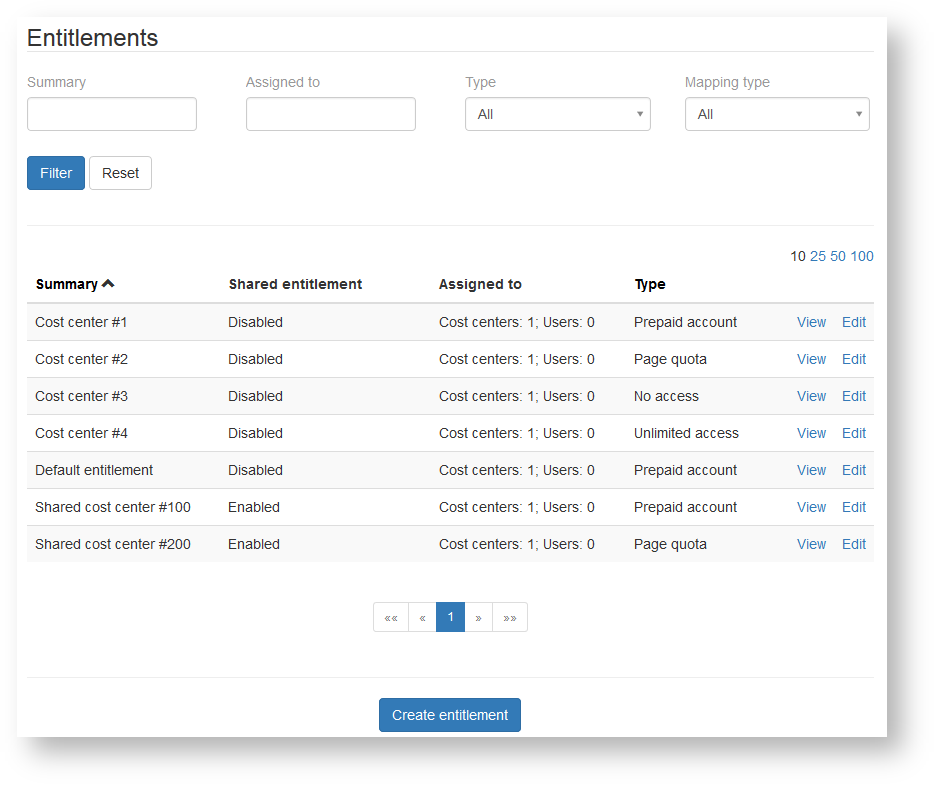
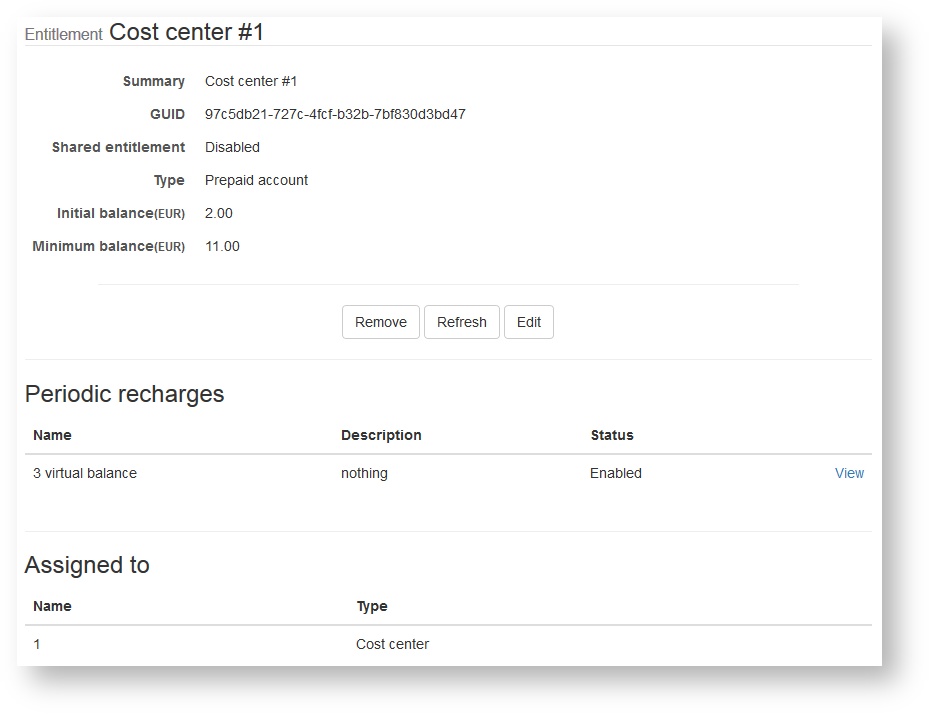
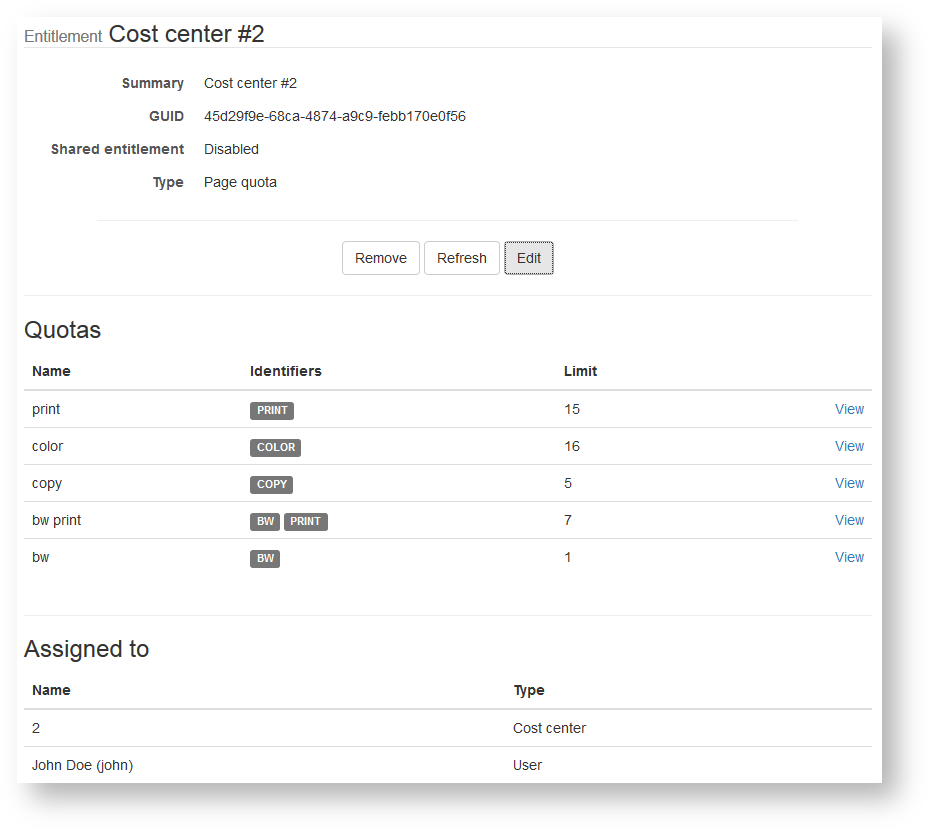
Entitlement Attributes
|
Attribute |
Description |
|
Summary |
Summary used for better identification of entitlement in Administration web interface. |
|
GUID |
Unique entitlement identifier. |
|
Type |
There are four possible values:
|
|
Shared entitlement |
This attribute distinguishes between two basic modes:
It is not possible to change this attribute once the entitlement was created. |
|
Cost center number |
Cost center number or list of numbers used as entitlement matching criteria. |
|
Usernames |
Dispatcher Paragon username or list of usernames used as entitlement matching criteria. Entitlement assigned to username will always take precedence before cost center number. This mean that Dispatcher Paragon user assigned to an entitlement by his username, will be always matched by this entitlement, even if user's cost center number is used in different entitlement. |
|
Assigned to |
Table of entitlement matching criteria. There are two possible type values, Cost center and User. |
|
Initial balance |
This attribute is specific to Prepaid account entitlement. It will grant initial virtual balance to all newly created subjects matched by this entitlement. Existing subjects are not affected by this option. For more information about virtual balance, see Subject Attributes. Initial virtual balance is assigned to a default safeq API user. For more information about API users, see API Users. It also possible to assign global initial balance in configuration of Dispatcher Paragon Payment System. |
|
Minimum balance |
This attribute is specific to Prepaid account entitlement type. It will set minimum balance to all existing or new subjects matched by this entitlement. For more information about minimum balance, see Subject Attributes. |
|
Periodic recharges |
This attribute is specific to Prepaid account entitlement type. It defines a list of period recharges, which will be assigned to all existing or new subjects matched by this entitlement. For more information about periodic recharges, see Periodic Recharges. |
|
Quotas |
This attribute is specific to Page quota entitlement type. It defines a list of quotas, which will be assigned to all existing or new subjects matched by this entitlement. For more information about periodic recharges, see Quotas. |
Entitlement Actions
|
Action |
Description |
|
Create entitlement |
Opens a form for creation of new entitlement. Saving of entitlement will create or update all subjects matched by entitlement criteria. |
|
Edit |
Opens a form for editing of entitlement. Saving of entitlement will create or update all subjects matched by entitlement criteria. The same action is triggered by Refresh button. Edit of Quotas attribute will reset all manual quota increases and consumed quotas or in other words, assigned quota subjects will act as if they were new records. |
|
Remove |
Removes selected entitlement. All already assigned subjects or those matched by entitlement criteria will be assigned to a default entitlement. It is not possible to remove default entitlement. |
|
Refresh |
Button is displayed only for non-defaulf entitlements with disabled sharing. It checks Dispatcher Paragon users in cost centers used in matching criteria of this entitlement and it assign or reassign found subjects from this entitlement. The same action is triggered by editing entitlement matching criteria. |
Subjects
Subjects represent users from external user management (usually from Dispatcher Paragon) with some additional stored information. There are three distinct subject types determined by assigned entitlement: Prepaid account (subject uses money operations), Page quota (subject uses quota operations), No access (subject is not used in operations from Dispatcher Paragon Payment System) and Unlimited access (subject can print or copy without limit). Subjects are further distinguished by their entitlement's attribute Shared entitlement to two basic groups: Personal (each subject has its own balance or remaining quota) and Shared (each subject shares its balance or remaining quota with all users matched by assigned entitlement). Creation of new subjects is handled automatically by saving entitlements or by transaction requests from other Dispatcher Paragon subsystems (see Entitlements).
Prepaid account subject type was in former versions of Dispatcher Paragon Payment System called customer.
Accounts with unlimited access are not listed among subjects due to the current way of implementation.
Following examples show a list of personal subjects and details of prepaid account and page quota subject type. Possible attributes and actions are described below.
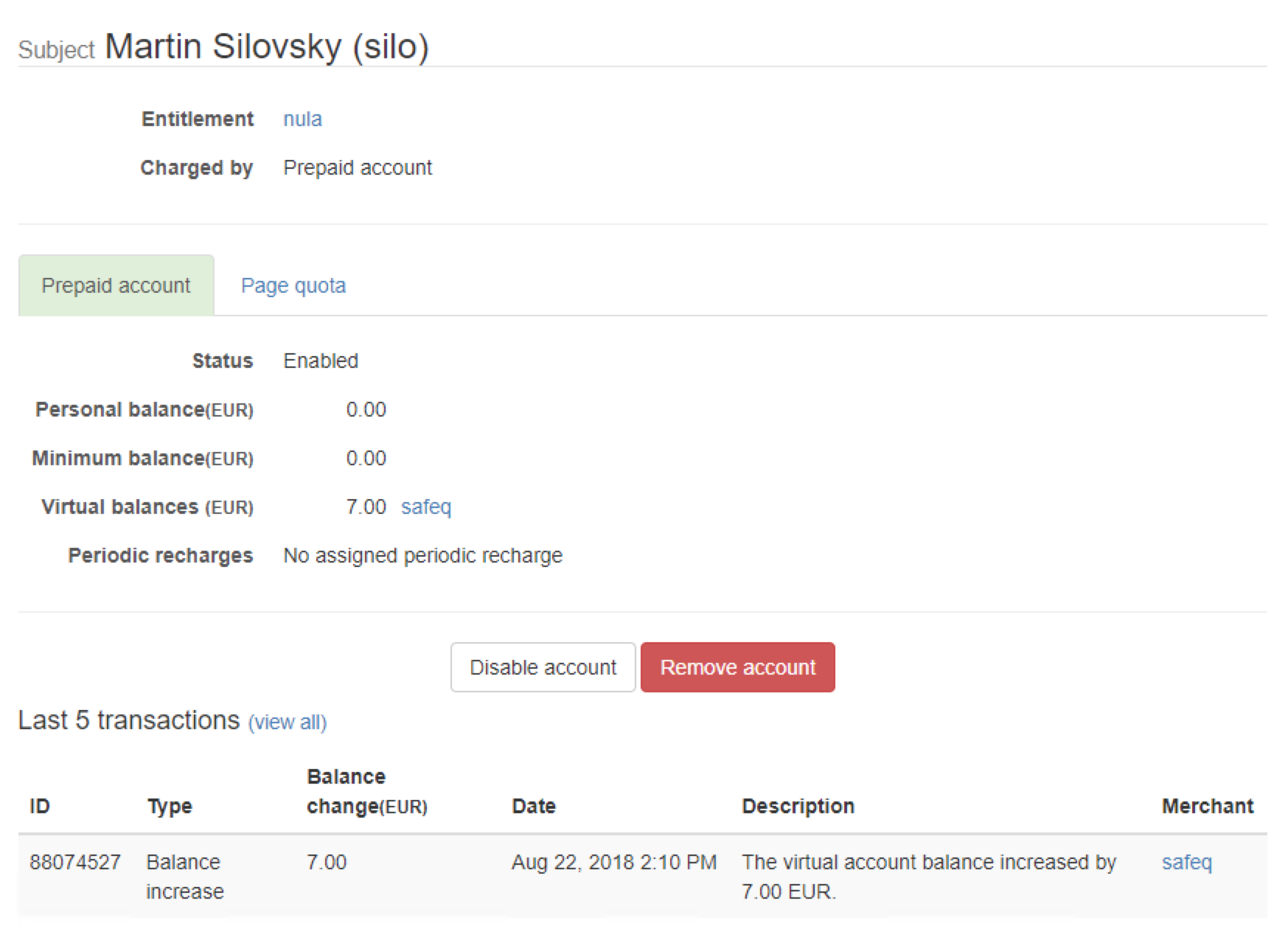
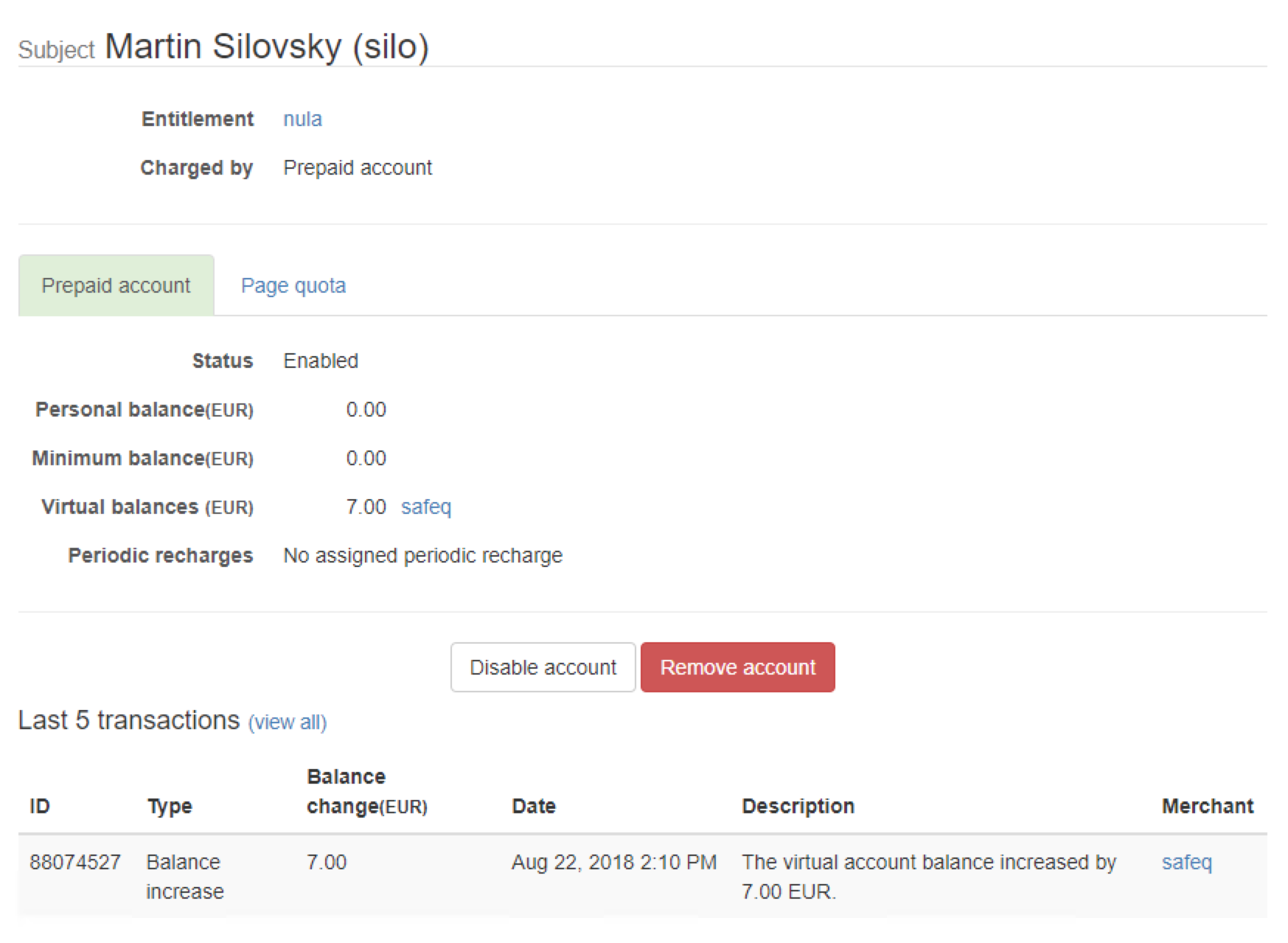
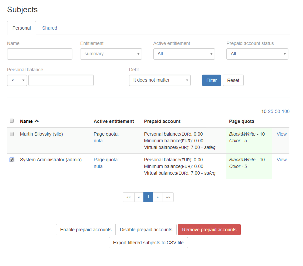
Subject Attributes
|
Attribute |
Description |
|
Name |
Name is automatically assigned during subject creation. In case of Personal subject, the name is usually represented in form of "Name Surname (username)", where both values originates in Dispatcher Paragon user. In case of Shared subject, the name corresponds to the cost center number. Subject name is automatically synchronized with Dispatcher Paragon user after the opening of subject in Using Cash Desk interface (Dispatcher Paragon Payment System). There is limitation with names of Quota and Shared subjects, which are never synchronized with Dispatcher Paragon. |
|
Active Entitlement |
Type and name of the assigned entitlement. Possible values are prepaid account , page quota, no access and unlimited access. Their values correspond to the assigned entitlement. For more details, see entitlement types in Entitlement Attributes. Personal subjects of no access type are not displayed in Administration web interface. |
|
Status |
Status is indicated by a color of a user's account. If the account's background is green, then the account is active based on assigned entitlement. If it is grey, then the account is disabled. If it is orange, then the account is active based on assigned entitlement, however, the account is disabled (this should not been common case). Possible values are:
There is also Removed status, which is not visible from Administration web interface. In relation to the other Dispatcher Paragon subsystems, disabled and removed subjects, behave like subjects with no access entitlement. |
|
Personal Balance |
Personal balance represents subject's real money deposited by cash desk, payment gateway or redeemed by a voucher. Each customer can have only one personal balance. |
|
Virtual Balance |
Virtual balance represents customer's bonus or free credit. It can be provided by periodic recharge, manual increase or by setting an initial account balance. Each customer can have many virtual balances, each assigned to a different API user merchant role, but in most cases there is only one named safeq. In case of transaction settlement, drawing of virtual balance take always precedence before personal balance. For more information about transaction settlement, see Working with Payment System. |
|
Minimum Balance |
Minimum balance represents a value below, which the personal balance cannot be decreased. Its value can be positive, zero or even negative. Virtual balance is not affected by minimum balance. Its minimum value is always zero. |
|
Periodic recharges |
List of assigned periodic recharges. |
|
Debts |
Debts represent total overdrawn value of personal balance. Similar to virtual balance, each debt is assigned to a different API user. For more information about debt configuration, see Working with Payment System and configuration of Dispatcher Paragon Payment System. |
|
Reservations |
Reservations represent blocked personal and/or virtual balance. For more information about reservations, see Reservations. |
|
Transactions |
Transactions represent history of balance changes. For more information about transaction types, see Report Attributes. |
|
Open deposits |
Open deposits represent unfinished payment gateway deposits. For more information, see Using Dispatcher Paragon end user interface. |
|
Quotas |
Assigned Quotas and their consumed and remaining values. Each subject can have several different quota limits. If you subject uses quotas with the same identifiers (aka services), for example "BW" and "PRINT, BW", then each use of "PRINT, BW" service, will also spend the "BW" service.
|
Subject Actions
Most of the subject attributes can be managed from menu Entitlements.
|
Attribute |
Description |
|
|
This action is available only for Page quota subject type. It serves for manual increase of quota limit for the selected subject. For more detail about quota limit, see Quotas. All manual increases are discarded during quota reset. |
|
Enable prepaid account |
This action enable the prepaid account if it is disabled. |
|
Disable prepaid account |
This action disable the prepaid account if it is disabled. |
|
Remove prepaid account |
This action remove the prepaid account and also clear all balances and annul all debts. |
|
Export filtered subjects to CSV file |
All subjects which correspond with a current filter will be exported to a CSV file |
Quotas
Quota represents a limit of some service or combination of services provided by Dispatcher Paragon. Available services are Print, Copy, Black&White, Color and Any (aka ALL_PAGES). Quotas are assigned to subjects (either as personal or shared) through configuration of entitlements. Each quota defines quota reset (aka recurrence), which after a specified of time, will reset all spent quotas to its default limit.
Accounting of quotas depends on configuration of entitlements and vendor specific behavior.
Following examples show a list of quotas, creation of new quota and quota detail. Possible attributes and actions are described below.
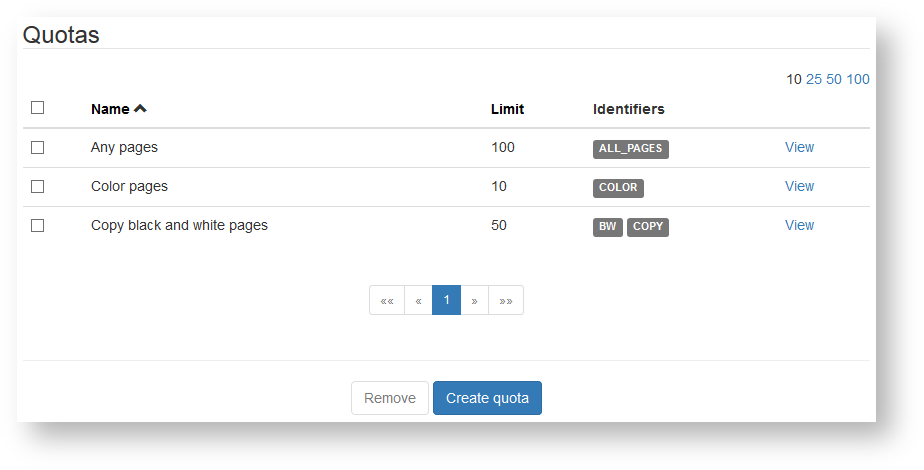
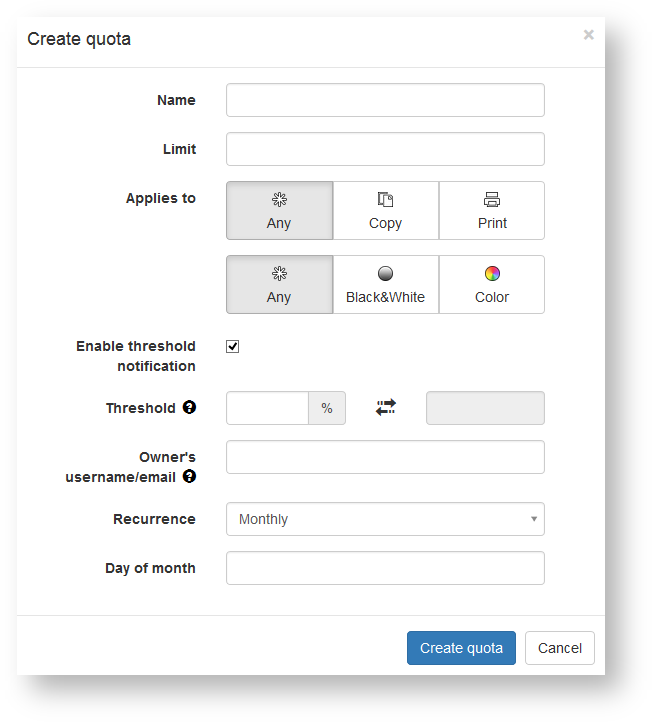
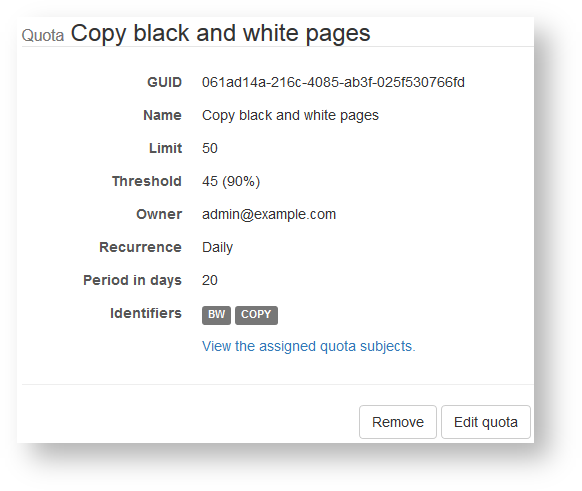
Quota Attributes
|
Attribute |
Description |
|
Name |
Unique quota name. |
|
Limit |
Quota limit. This limit will be assigned to each subject with this quota. This limit can be increased individually on the subject detail. Setting quota limit to zero will automatically deny all quota reservations for specified quota identifiers. |
|
Identifiers / Applies to |
Identifiers are in fact services available in Dispatcher Paragon. These can be spent by a user. Not all combinations are valid (for example "Print Copy" is invalid). |
|
Recurrence |
Recurrence specifies how often should Dispatcher Paragon Payment System reset a quota limit. Following options are possible:
Please note that if you specify day of the month from interval 29-31, than the recharge will not be executed if the month does not have given amount of days - e.g. February does not have day 30 or 31 |
|
Enable treshold notification |
Enables configuration of treshold notification. |
|
Treshold |
Defines a proportion (in comparison to quota limit) or amount of consumed quota which will trigger quota notification. Be aware, that your Dispatcher Paragon Payment System should have a valid SMTP configuration and enabled quota notifications, before the actual email treshold notification can be sent. For more detail, see Notifications. |
|
Owner / Owner's username/email |
Dispatcher Paragon username or valid email. In case of username, related Dispatcher Paragon should have a valid email, which will be used for notification when treshold is reached. |
Quota Actions
|
Action |
Description |
|
Create quota |
Displays "Create quota" page. |
|
Edit quota |
Displays "Edit quota" page. |
|
Remove |
Removes quotas. It is not possible to remove assigned quota, at first, you should remove it from entitlement. |
Periodic Recharges
Periodic recharge increases virtual balance of assigned subjects on a regular basis. Since each virtual balance is bound to a merchant (API user with merchant role), periodic recharges are also bound to a merchant.
Following examples show a list of periodic recharges and periodic recharge detail. Possible attributes and actions are described below.
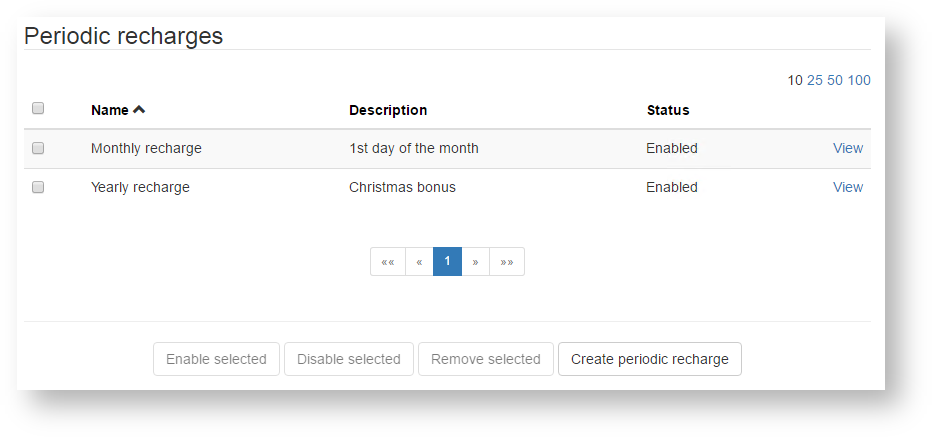

Periodic Recharges Attributes
|
Attribute |
Description |
|
Name |
Periodic recharge name |
|
Description |
Optional periodic recharge description |
|
Status |
There are two possible statuses:
|
|
Assigned merchant |
Merchant (API user with merchant role), which identifies type of subject's virtual balance to be credited. |
|
Type |
Periodic recharges can be set up to:
|
|
Recurrence |
Recurrence specifies periodicity of the recharge. Following options are possible:
Please note that if you specify day of the month from interval 29-31, than the recharge will not be executed if the month does not have given amount of days - e.g. February does not have day 30 or 31 In case your Dispatcher Paragon Payment System was not running during some scheduled periodic recharge, don't worry, because all enabled periodic recharges are always executed retroactively or in other words all missed scheduled recharges will be executed at the first possible moment. |
|
Start |
Recharge will start executing at the first possible moment after specified start date. Start date must be set to be in the future. |
Periodic Recharges Actions
|
Action |
Description |
|
Enable recharge / Enable selected |
Changes status of selected recharges to enabled. |
|
Disable recharge / Disable selected |
Changes status of selected recharges to disabled. |
|
Remove recharge / Remove selected |
Removes periodic recharge. Removed recharges remain in database for auditing purposes, but they are no longer visible in the Administration web. Recharge is inactive. |
|
Create periodic recharge. |
Opens "create periodic recharge" page. |
|
View assigned customers |
Shows page with list of subjects currently assigned to the recharge. Subjects can be assigned or unassigned from the recharge. |
Cash desks
Cash desks represents information about some physical place, where cash desk operators increase, decrease or refund balance on subject accounts on behalf of account owners. In an example scenario, a person, who would like to deposit money into money account, visits cash desk operator. Operator will deposit money on person's account through the Cash Desk web interface. This operation would increase both cash desk balance (where real money are stored) and personal balance (where electronic money are sent). For more information about usage of cash desks, see Using Cash Desk interface (Dispatcher Paragon Payment System).
Following examples show a list of cash desks and cash desk detail. Possible attributes and actions are described below.
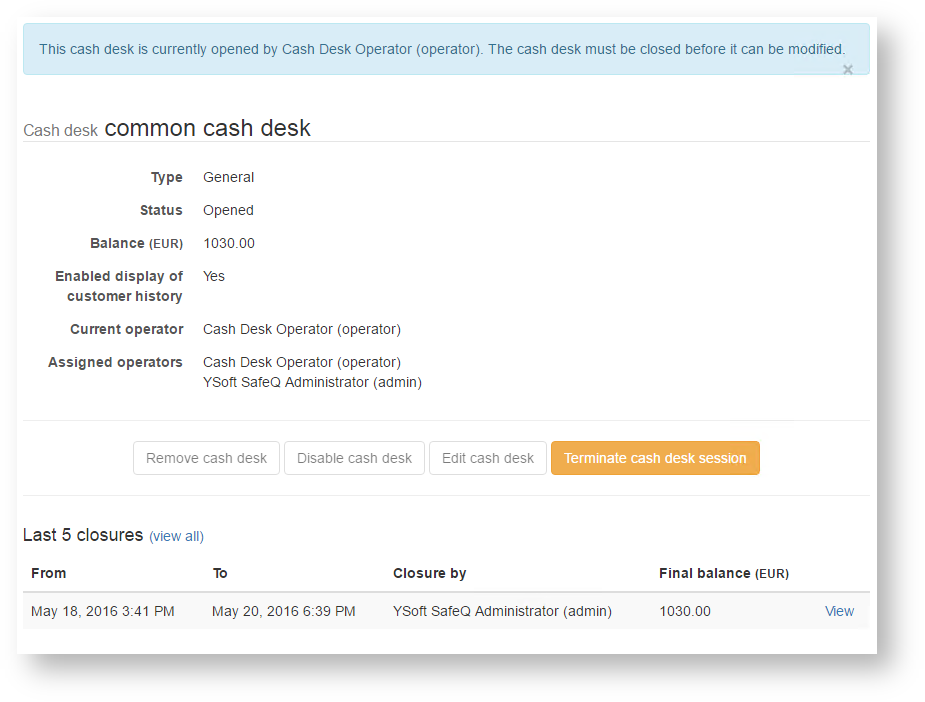
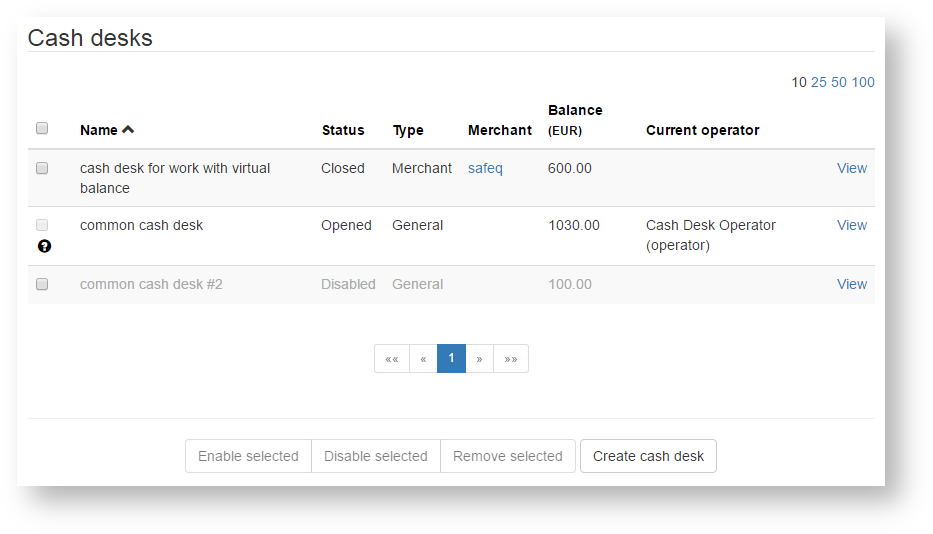
Cash Desk Attributes
|
Attribute |
Description |
|
Name |
Cash desk name is used by cash desk operator in Cash Desk web interface as a main discriminator among different cash desks. |
|
Status / Initial status |
There are several available values for cash desk status:
|
|
Type |
Cash desk type affects functionality on detail of subject in the Cash Desk web interface. Possible types are:
|
|
Merchant |
API user merchant role assigned to the cash desk with "merchant" type. |
|
Balance / Initial balance |
In case of general cash desk type, the cash desk balance represents real money used for deposit or withdrawal from subject personal balance. In case of merchant cash desk type, there in no balance, because all operations affects only virtual balances. |
|
Enabled display of customer history |
There are two possible values:
|
|
Current operator |
Name of the cash desk operator, who lastly opened the cash desk. |
|
Assigned operators |
You can select Dispatcher Paragon users with role "cash desk operators". These users will see this cash desk after login into Cash Desk web interface (assuming that the cash desk is not disabled). |
Cash Desk Actions
|
Action |
Description |
|
Create cash desk |
Create a new cash desk. After the setting of initial balance, all other cash desk balance adjustments have to be performed in Cash Desk web interface through actions "Deposit into cash desk" and "Withdraw from cash desk". |
|
Edit cash desk |
Edit cash desk attributes. |
|
Remove cash desk / Remove selected |
Remove the cash desk. It will be no longer visible in the Administration web or Cash Desk web. |
|
Enable cash desk / Enable selected |
Change cash desk status to "Enabled". |
|
Disable cash deks / Disable selected |
Change cash desk status to "Disabled". |
|
Terminate cash desk session |
Forcibly perform transition to "Closed" status. This will make cash desk available for all assigned operators and it will allow administrator to edit cash desk attributes. |
YSoft Payment Machines
YSoft Payment Machines allow users to deposit money to their Dispatcher Paragon Payment System account without assistance of administrator or cash desk operator. For more detail about connecting of new YSoft Payment Machine, see Configuring YSoft Payment Machine.
Following examples show a list of payment machines and payment machine detail. Possible attributes and actions are described below.
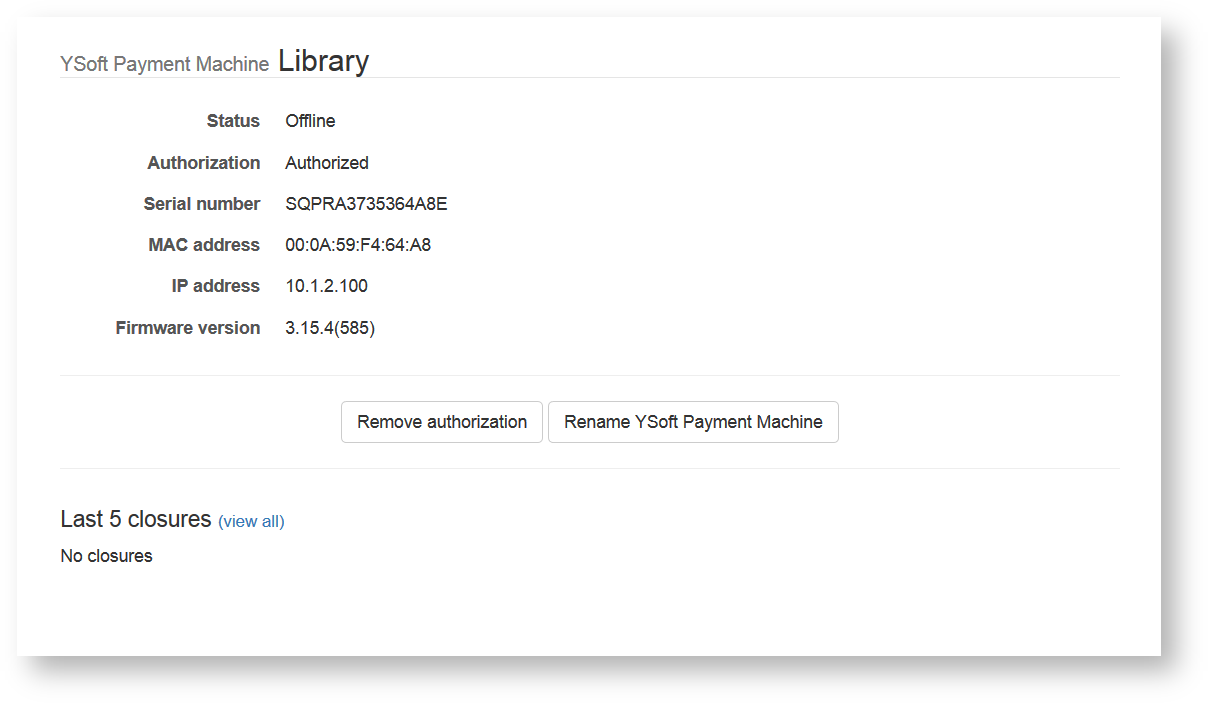
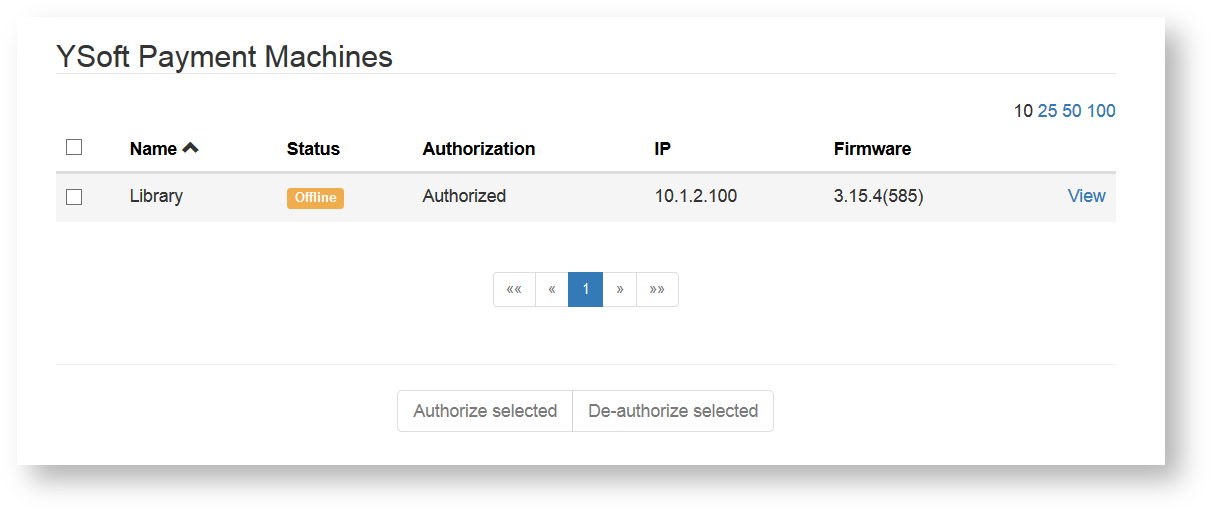
YSoft Payment Machines Attributes
|
Attribute |
Description |
|
Name |
Name of the YSoft Payment Machine. Name is used for better identification of YSoft Payment Machine in the web administration (e.g. location). |
|
Status |
Online status of the YSoft Payment Machine. Useful for troubleshooting. |
|
Authorization |
Authorization status. Unauthorized machines cannot communicate with Dispatcher Paragon Payment System. |
|
IP |
YSoft Payment Machine IP address. |
|
Firmware |
YSoft Payment Machine firmware version. |
|
Serial number |
YSoft Payment Machine serial number. |
|
MAC address |
YSoft Payment Machine mac address. |
|
Closure |
List of deposits for certain time period. For more details see Operating YSoft Payment Machine. |
YSoft Payment Machines Actions
|
Action |
Description |
|
Grant authorization / Authorize selected |
Authorizes YSoft Payment Machine allowing it to connect to Dispatcher Paragon Payment System. |
|
Remove authorization / De-authorize selected |
De-authorizes Payment Machine making it unable to connect to Dispatcher Paragon Payment System. |
|
Rename YSoft Payment Machine |
Shows dialog for renaming of YSoft Payment Machine. |
Payment Gateways
Payment Gateways tab allows you to setup integration with payment gateways through payment gateway plugins. For more detail about installation, see Payment Gateway Plugin deployment . Connected payment gateways are displayed to clients as gateway options on their payment gateway deposit screens. For more detail about payment gateway deposit, see Using Dispatcher Paragon end user interface. List of supported gateways can be found here Supported Payment Gateways.
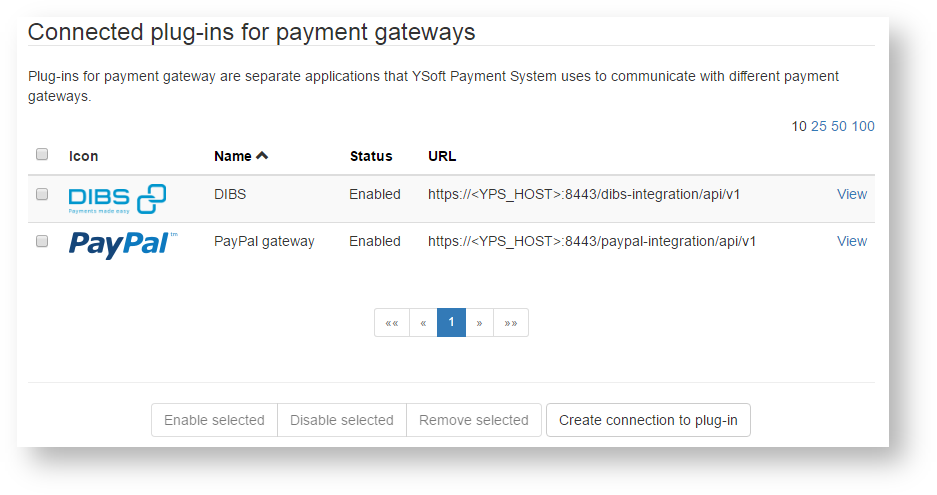
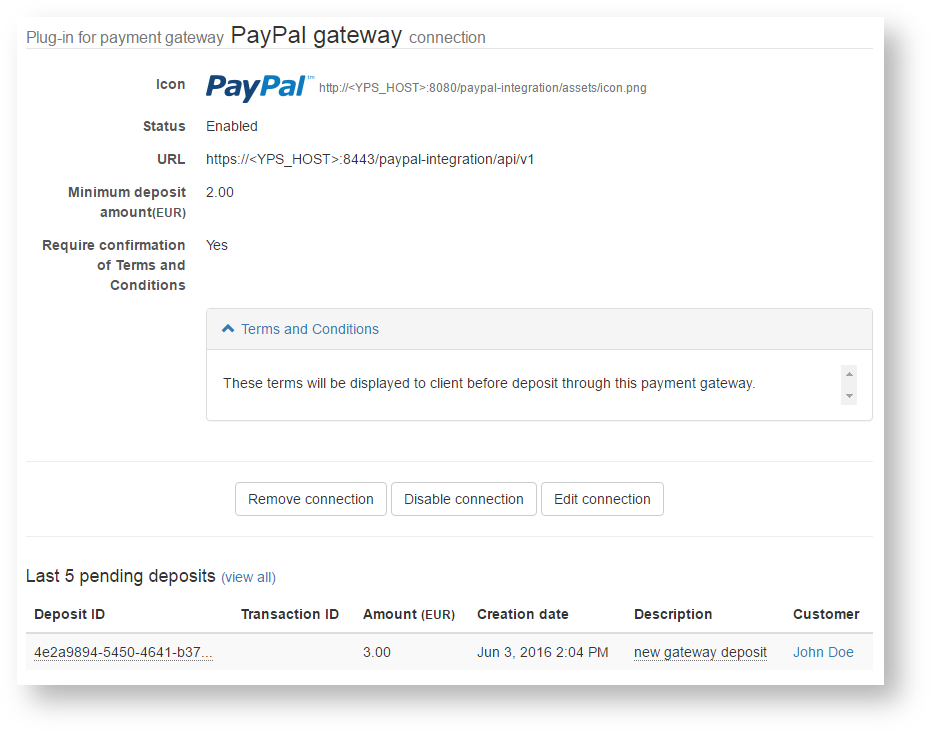
Payment Gateways Attributes
|
Attribute |
Description |
|
Name |
Descriptive name of the plugin. This name will be used as gateway icon tool tip on payment gateway deposit page. |
|
URL |
URL to the payment gateway plugin. At the moment Dispatcher Paragon Payment System supports two types with these default URLs:
Use Dispatcher Paragon Payment System server (or server where your payment gateway plugins are installed) true IP instead of "YPS_HOST". Payment gateway plugin need to be installed before using these URLs. Do not use localhost or 127.0.0.1 instead of "YPS_HOST", because this URL be used by clients for their payment gateway deposits. |
|
Icon URL |
URL to the payment gateway icon. This icon helps visually distinguish the payment gateways. You can use either URL to the image from internet or you can use these two defaults:
Use Dispatcher Paragon Payment System server (or server where your payment gateway plugins are installed) true IP instead of "YPS_HOST". We are deliberately using http protocol instead of https in this case, because https can cause problems with visibility of icon in some browsers. |
|
Minimum deposit amount |
Minimum amount for one deposit. Bigger amount are usually used in case of payment gateway, which charges transaction fees. |
|
Status |
Possible values are:
|
|
Require confirmation of terms and conditions |
Flag indicating whether user must accept terms and conditions prior to transferring money through the payment gateway. |
|
Terms and conditions |
Text of terms and conditions which is displayed when the confirmation is required. |
Payment Gateways Actions
|
Actions |
Description |
|
Enable connection / Enable selected |
Enables selected payment gateway connection |
|
Disable connection / Disable selected |
Disables selected payment gateway connection. |
|
Remove connection / Remove selected |
Removes selected payment gateway connection. Payment gateway information is still kept in system for auditing purposes, but the payment gateway is not accessible from the the web administration. |
|
Create connection to plug-in |
Opens create plug-in connection dialog |
|
Edit connection |
Opens edit plug-in connection dialog |
Vouchers
Vouchers represent an alternative way of depositing money to subject personal balance by generating voucher codes with some assigned amount. These codes can be later redeemed by cash desk operator from Cashdesk web interface or by client through his Dispatcher Paragon end user interface.
Following example shows a list of vouchers. Possible attributes and actions are described below.
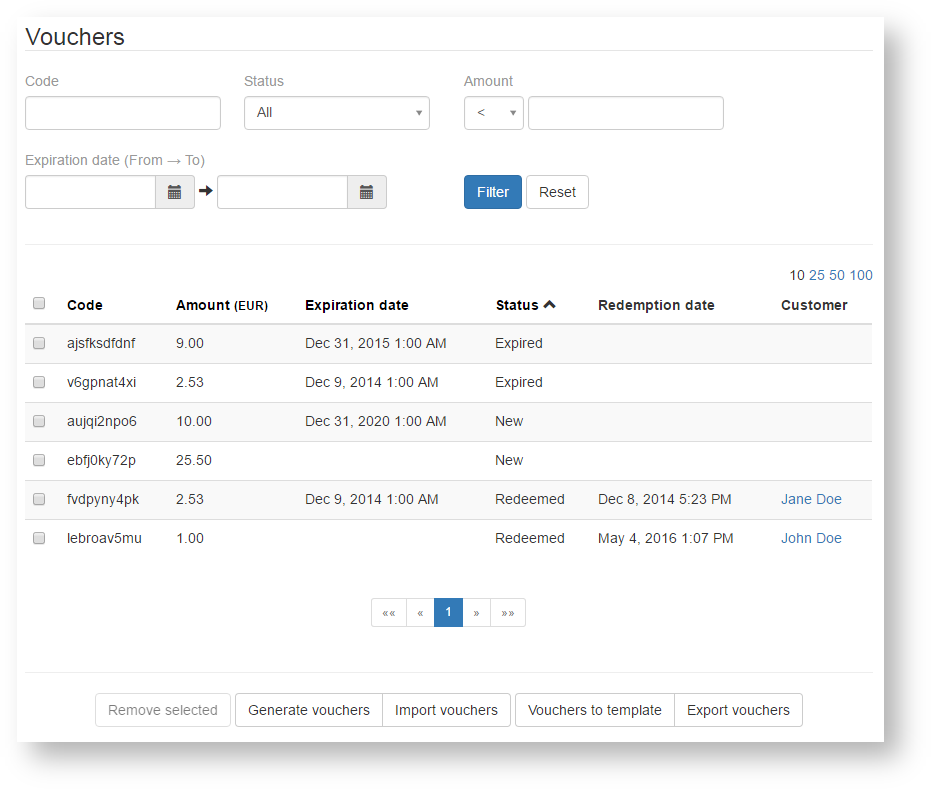
Voucher Attributes
|
Attribute |
Description |
|
Code |
Unique code identifying the voucher. |
|
Amount |
Amount by which the personal balance would be or was increased. |
|
Expiration date |
If a voucher with New status exceeds this limit, it be automatically switched to Expired status. Vouchers with no expiration date will never expire. |
|
Status |
Possible values are:
|
|
Redemption date |
Date when the voucher was redeemed. |
|
Customer |
subject who redeemed the voucher. |
Voucher Actions
|
Action |
Description |
Example |
|
Remove selected |
Remove selected vouchers. Removed vouchers remain in database for auditing purposes, but they are no longer visible in the Administration web and they cannot be redeemed. |
|
|
Generate vouchers |
This action allows you to generate many New vouchers with random codes in one batch. Possible attributes are:
|
|
|
Import vouchers |
This action allows you to import many New vouchers with given code from the CSV file. Possible columns in CSV file are:
|
|
|
Vouchers to template |
In order to distribute new voucher codes to your money account owners, you can export your vouchers into printable file. This action requires DocX template with updatable fields, where each field represents voucher code. Selected vouchers will be exported into this template. Here are possible attributes:
Only vouchers in New status will be exported into output file. |
|
|
Export vouchers |
This action allows you to export vouchers into CSV file. There are two basic modes.
|
|
API Users
API user represents account, which can access Dispatcher Paragon Payment System REST APIs. These APIs allow integration of Dispatcher Paragon Payment System with Dispatcher Paragon subsytems and other third party systems. API user can have different roles (for example Merchant, Cashdesk, Admin, Balance management). API user named safeq is always created as a default.
Since safeq API user is usually used by the rest of Dispatcher Paragon suite, its credentials are also stored in Dispatcher Paragon > System settings > Dispatcher Paragon Payment System under options paymentSystemApiUserName and paymentSystemApiPassword .
Following examples show a list of API users and API user detail. Possible attributes and actions are described below.
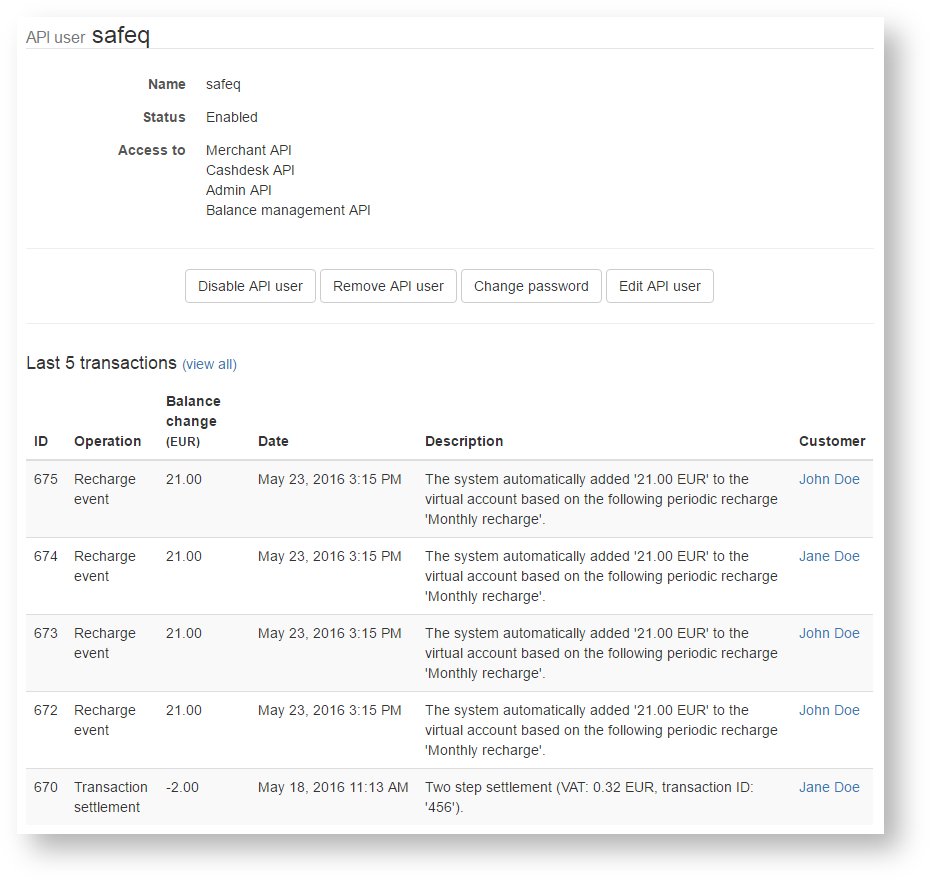

API Users Attributes
|
Attribute |
Description |
|
Name |
Name of the API user. Used for API authentication. |
|
Password |
Password used for API authentication. |
|
Status |
Current status of the API user. Possible values are:
|
|
Merchant API |
Access to Merchant APIs - APIs for transaction processing (reservations, settlements). |
|
Cashdesk API |
Access to Cashdesk APIs - APIs for deposits, withdrawals or closures on a Cashdesk. |
|
Admin API |
Access to Admin APIs - APIs for management of subjects, money accounts or periodic recharges. |
|
Balance Management API |
Access to Balance Management API - APIs for increasing or decreasing virtual account balance. |
API Users Actions
|
Action |
Description |
|
Enable API user / Enable selected |
Enables or unlocks selected API users. |
|
Disable API user / Disable selected |
Disables selected API users. |
|
Remove API user / Remove selected |
Removes selected API users. Removed API users remain in database for auditing purposes, but they are no longer visible in the Administration web. |
|
Create API user |
Opens create API user dialog. |
|
Change password |
Opens change password dialog. |
|
Edit API user |
Opens edit API user dialog used for change of API user access. |
System Incidents
System incidents section is used as:
-
Early warning system - to notify system administrator about urgent situations needed to be fixed ASAP (for example "payment gateway is down" - sysadmin should fix it before first user would be affected)
-
Suspicious activity detection - to detect risky or unusual activity in system and let admin check the risks related.
Following examples show a list of grouped incidents, list of incidents from one group and detail of one incident. Possible attributes and actions are described below.
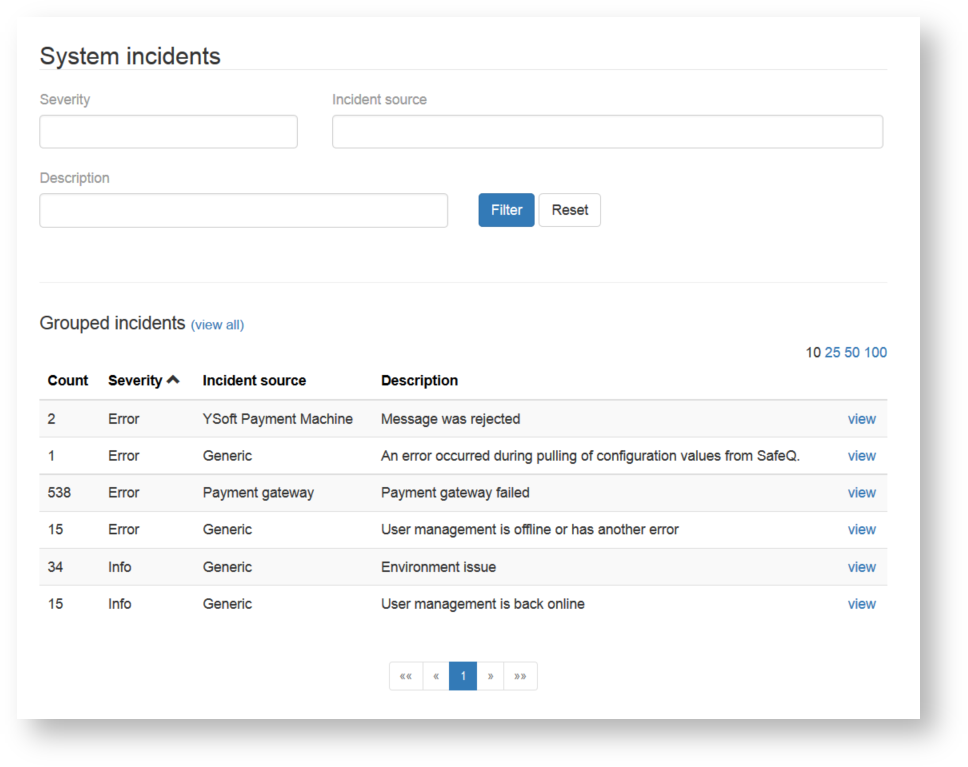
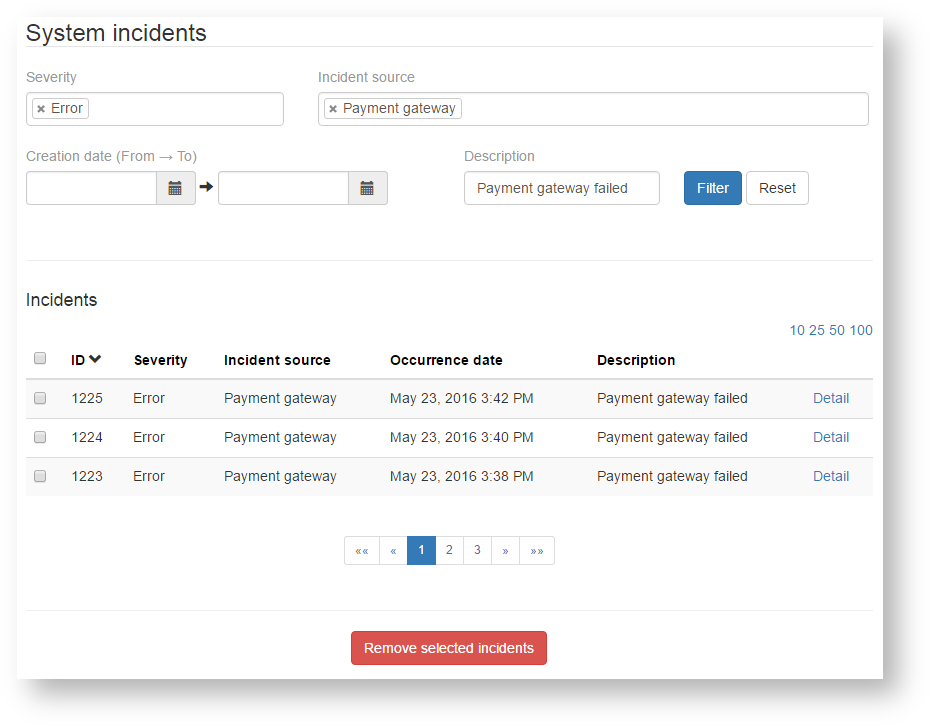
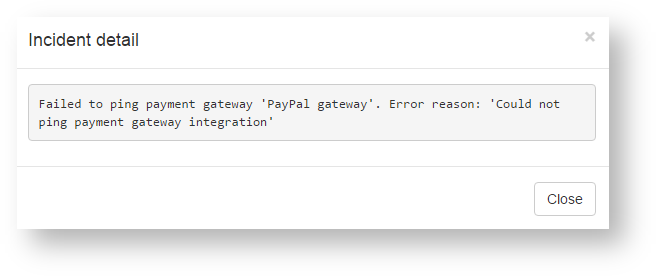
System Incident Attributes
|
Attribute |
Description |
|
Count |
Incident occurrence count. Incidents of the same kind may occur many times so they are grouped together for better readability. |
|
Severity |
Severity can have following values:
|
|
Incident source |
Identifies part of the system, which generated the error. |
|
Decription |
Incident description. |
|
Occurrence date |
Date of incident occurrence. |
|
Incident detail |
More detailed incident description. |
System Incident Actions
|
Action |
Description |
|
Remove selected incidents |
Permanently deletes selected incidents. |
Reports
Reports contain filterable list of all transactions from Dispatcher Paragon Payment System.
Following example shows a transaction history. Possible attributes and actions are described below.
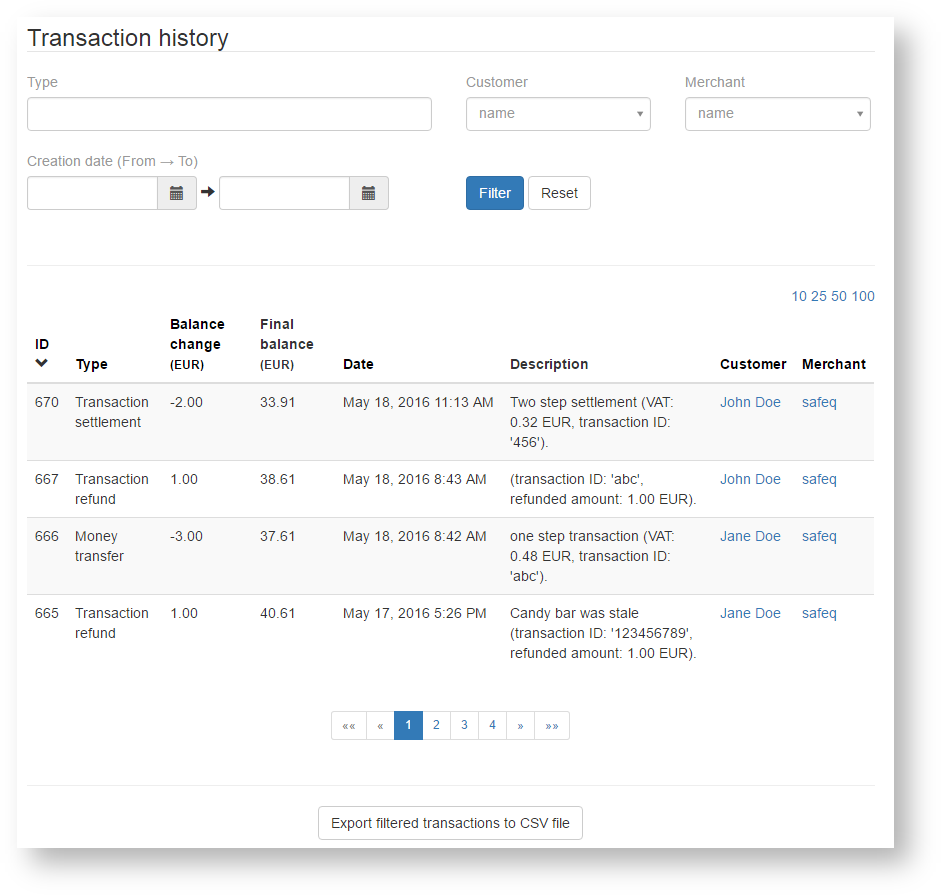
Report Attributes
|
Attribute |
Description |
|
ID |
Internal system identifier of the transaction. |
|
Type |
Type of transaction can have following values:
|
|
Balance change |
Amount of the transaction. |
|
Final balance |
Account balance after the transaction was performed. |
|
Date |
Transaction processing date. |
|
Description |
Transaction description - provided by merchant. |
|
Customer |
Name of the subject, whose account participated in the transaction. |
|
Merchant |
API user, who initiated the transaction. |
Report Actions
|
Action |
Description |
|
Export filtered transactions to CSV file |
Download currently filtered transaction records as CSV file. |
Configuration
License
If this menu displays message "Dispatcher Paragon Payment System is fully activated", your Dispatcher Paragon Payment System is fully fuctions.
Otherwise check whether:
-
your Dispatcher Paragon license contains Dispatcher Paragon Payment System feature
-
your Dispatcher Paragon Payment System is properly connected to Dispatcher Paragon. For more detail, see Payment System deployment
Dispatcher Paragon Payment System without fully activated license will still allow login login into Administration web interface, but most actions will fail on "insufficient license" error.
Notifications
Dispatcher Paragon Payment System provides you with possibility to receive regular email notifications as an administrator or an account owner. Dispatcher Paragon Payment System uses SMTP configuration from Dispatcher Paragon. Periodic notifications are generated at midnight of a server's local date. System tries to deliver unsent notifications each 5 minutes. Interval can be changed by option notification.send-emails.cron. For more detail about advanced configuration, see Advanced configuration of Dispatcher Paragon Payment System.
There are four types of notifications available:
-
Account balance - Notification is issued once, when credit balance on money account goes under defined balance limit. Notifications are generated immediately after transaction settlement.
-
Transaction - Notification is issued once, when any transaction is performed on money account. Notifications are generated immediately after transaction settlement
-
Account statement - Notification is issued periodically and informs recipient about all settled transactions on money account during given period.
-
Transaction history - Notification is issued periodically and informs administrator about all settled transactions in Dispatcher Paragon Payment System during given period.
-
Quota reset - Notification is issued after each quota reset and it informs recipient about assigned subjects and their spendings.
-
Quota threshold - Notification is issued once the quota threshold is reached . Recipient can be admin or Dispatcher Paragon user, whose transaction reached the threshold.
-
Quota threshold owner - Notification is issued the quota threshold is reached . Recipient is quota owner defined on detail of quota. For more detail, see Quota Attributes.
Each notification can be customized using WYSIWYG editor and variables related to current type of notification. Click Save to apply changes in configuration of notifications.
Cash desks
Defines configuration for usage of cash desks. You can define rules for rounding, minimal amount for withdrawal and receipt formats (displayed in in Cash Desk web after deposit, withdrawal or refundation).
Cash desk template variable amount does not contain a currency symbol. If you wish to display currency on your cash desk receipts, insert it into template manually.
Dispatcher Paragon Payment System
This section describes basic configuration of Dispatcher Paragon Payment System accessible from Administration web interface. For more details about advanced configuration, see Advanced configuration of Dispatcher Paragon Payment System .
|
Configuration option |
Description |
|
Decimal places |
Any numeric input from the Administration or Cash Desk web interface is rounded to the given decimal places. The same is true for display of numbers in web interfaces. |
|
VAT |
This number determines, which part of transaction amount will be displayed as tax. |
|
Maximum account balance |
Maximum personal balance. Any deposit (or refund) exceeding this limit will fail. |
|
Initial account balance |
Initial virtual balance for newly created subjects. Balance is assigned to default safeq API user. Value of initial balance can be overridden before each subject creation (either from Dispatcher Paragon web of through REST API). You can also use entitlement attribute Initial Balance, which will assign initial virtual balance only to a specific group of users. For more detail, see Entitlement Attributes. |
|
Maximum number of refunds per payment |
Each transaction can be refunded by the given number of times (None, One, Many). |
|
Maximum refund time |
Transactions older than this interval cannot be refunded. |
|
Reservations older than given number of hours, will be automatically canceled. |
|
|
Expiration of pending deposits |
Open payment gateway deposits older that the given number of days, will be automatically canceled. |
|
Overdrawn transactions |
Enables or disables debt tracking in Dispatcher Paragon Payment System. It is recommended to use option Allow and register debt if necessary in you use Dispatcher Paragon Payment System with Dispatcher Paragon. |


 and descending
and descending  order. Sorting affects all table results, not just visible page.
order. Sorting affects all table results, not just visible page. 




